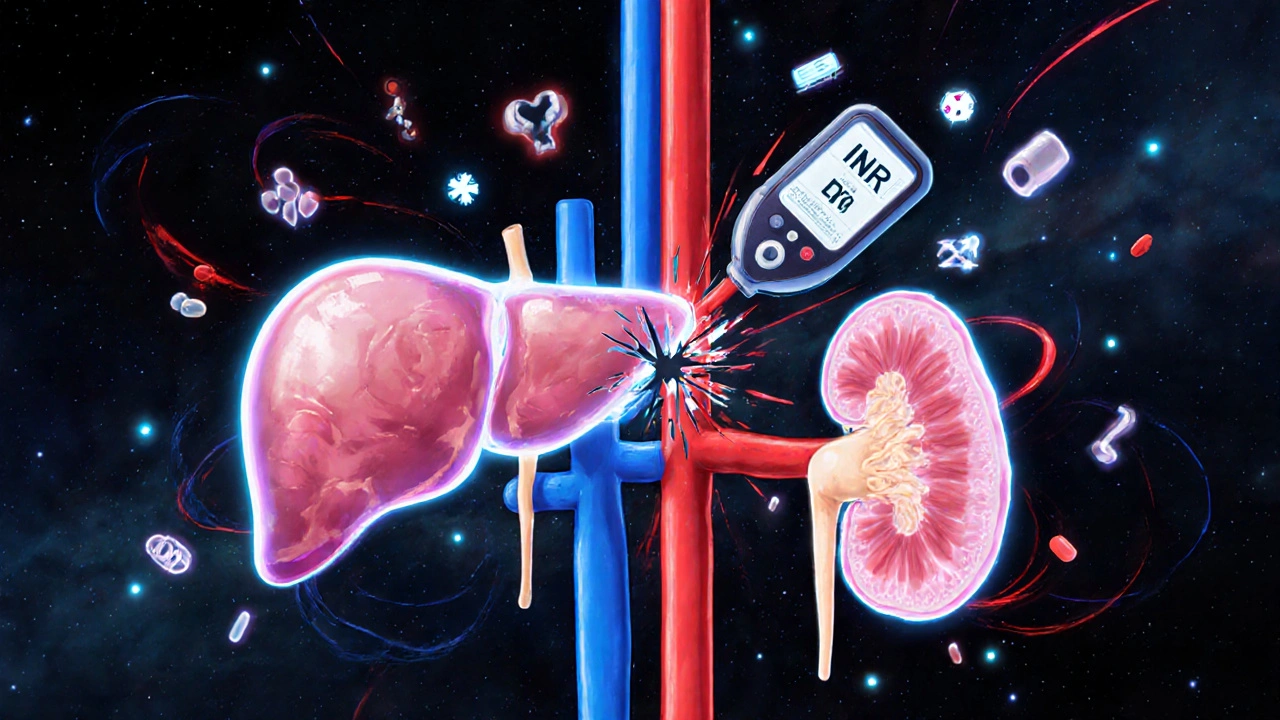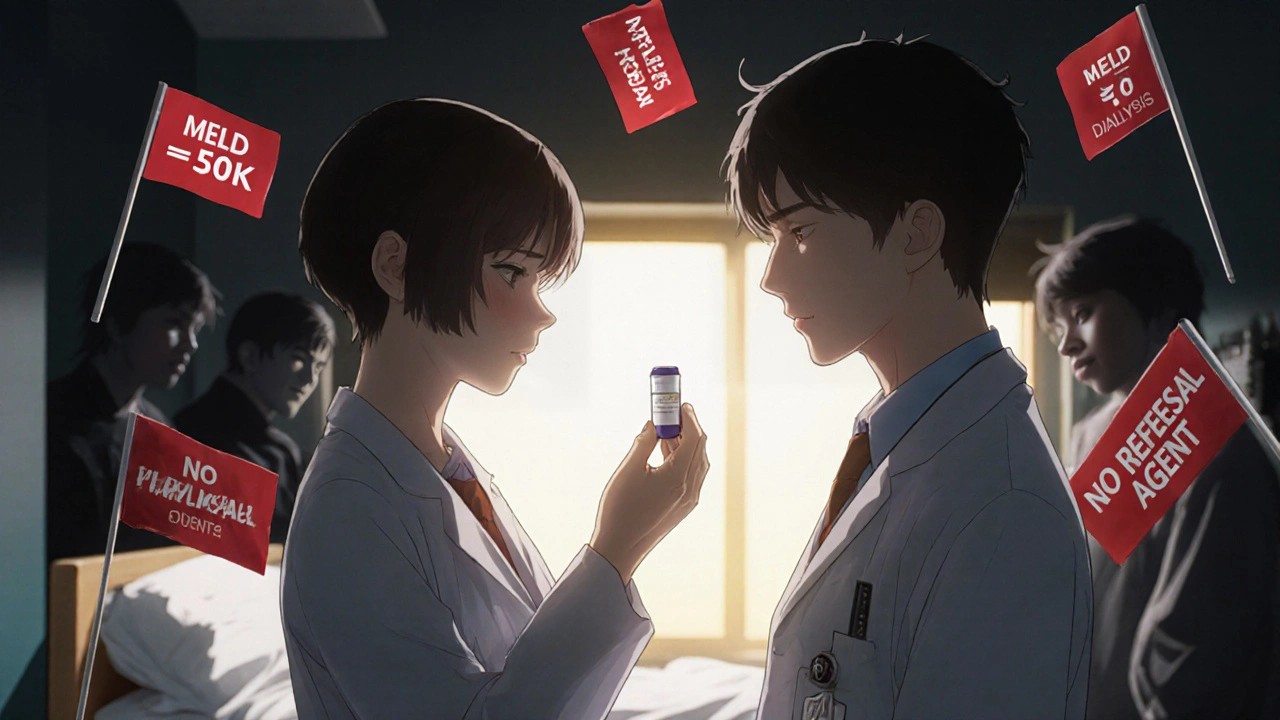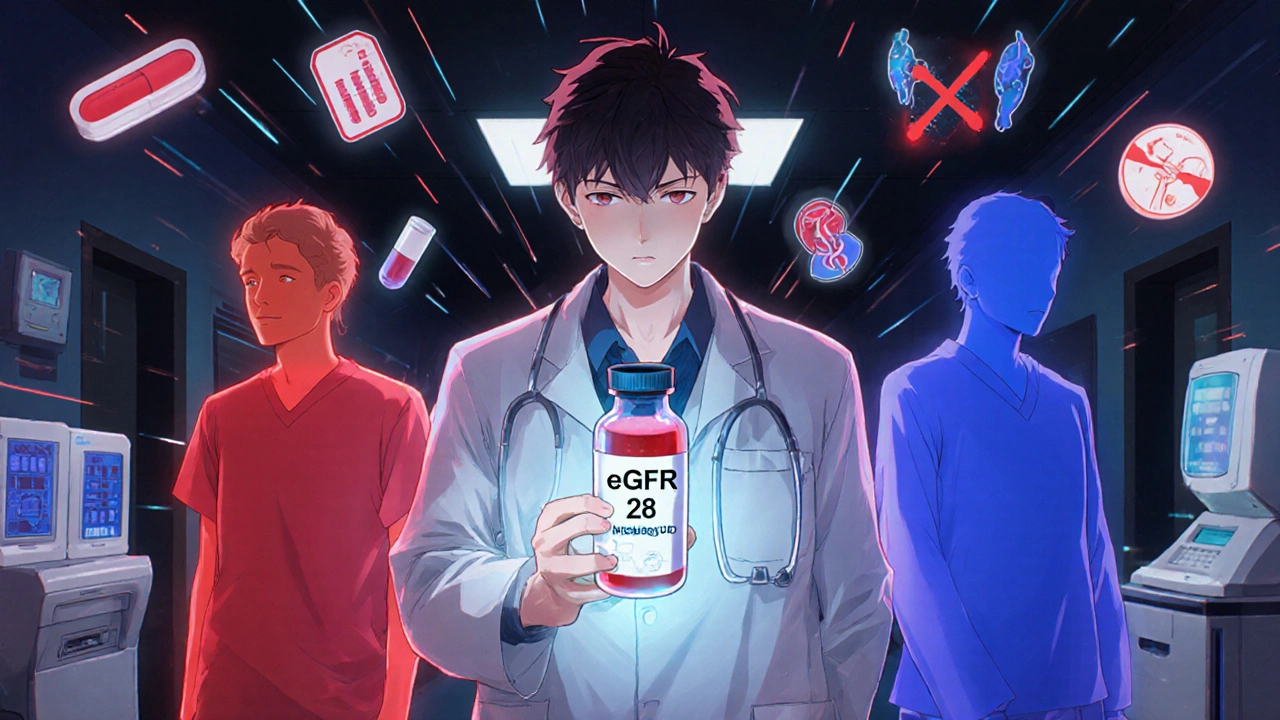Anticoagulation Decision Calculator
Clinical Parameters
Managing blood thinners in patients with both kidney and liver disease isn’t just tricky-it’s one of the most high-stakes decisions in modern medicine. These aren’t theoretical edge cases. In the U.S. alone, over 37 million people have chronic kidney disease, and nearly 6 million have chronic liver disease. Many of them also have atrial fibrillation, putting them at risk for stroke. But giving them standard blood thinners? That’s where things fall apart.
Why Standard Blood Thinners Don’t Work the Same Here
Most anticoagulants, especially the newer ones called DOACs (direct oral anticoagulants), were tested in healthy adults. The people with severe kidney or liver damage? They were left out. That means we’re guessing when we prescribe them. And guessing with blood thinners can mean the difference between a stroke and a fatal bleed. Take apixaban, for example. It’s the most forgiving DOAC in kidney disease. In people with eGFR below 30 mL/min, the FDA says you can still use it-but only at half the dose: 2.5 mg twice daily. Why? Because in the ARISTOTLE trial, those patients had a 70% lower risk of major bleeding compared to warfarin. That’s huge. But in dialysis patients? The data is thin. One study showed apixaban levels drop to about 40% of normal. That’s not zero-but it’s not enough to be confident. Rivaroxaban? The European Medicines Agency says don’t use it if your kidneys are failing. The FDA? Still allows it at 10 mg daily in dialysis, but the evidence is shaky. And dabigatran? It’s mostly cleared by the kidneys. At eGFR under 30, it’s outright banned. If you give it to someone on dialysis, you’re basically flooding their system with an unmetabolized drug.What Happens in Liver Disease? It’s Not Just About INR
Liver disease throws a whole other wrench in the system. The liver makes clotting factors. But it also makes anticoagulants like protein C and S. So when the liver fails, the body loses both the ability to clot and the ability to stop clotting. That’s why INR-the standard test doctors use to monitor warfarin-is useless here. An INR of 2.5 in a healthy person means they’re in the therapeutic range. In someone with cirrhosis? That same number might mean they’re dangerously under-anticoagulated. Why? Because INR only measures vitamin K-dependent factors. It ignores low platelets, low fibrinogen, and abnormal clotting dynamics. A 2019 study found that cirrhotic patients had a 42% variation in INR response compared to 28% in healthy people. That’s chaos. The American Association for the Study of Liver Diseases (AASLD) says DOACs are okay in Child-Pugh A (mild liver disease). For Child-Pugh B (moderate), use them with caution. For Child-Pugh C (severe)? Don’t use them at all. Why? Because the RE-CIRRHOSIS study found a 5.2-fold higher risk of major bleeding in these patients on DOACs.Apixaban vs. Warfarin: The Real Numbers
Let’s cut through the noise. What actually works better? In patients with stage 3-4 kidney disease, apixaban cuts major bleeding by 31% compared to warfarin. That’s not a small win. It’s life-changing. And in those same patients, DOACs reduce intracranial hemorrhage by 62%. That’s the kind of stroke that kills or leaves people permanently disabled. But here’s the catch: in end-stage kidney disease-especially on dialysis-the benefit fades. Some studies show warfarin might be safer here, particularly if the patient has a mechanical heart valve. Why? Because warfarin’s effects can be reversed quickly with vitamin K or fresh frozen plasma. DOACs? Only apixaban and rivaroxaban have a reversal agent (andexanet alfa), and it costs nearly $20,000 per dose. Most hospitals don’t even stock it. In liver disease, warfarin has a similar problem: it’s hard to keep in range. Only 45% of cirrhotic patients stay in the therapeutic window more than 60% of the time. That’s compared to 65% in people with healthy livers. That means more bleeding, more clots, more trips to the ER.
What Do Real Doctors Do in the Clinic?
A 2021 study of over 12,000 dialysis patients with atrial fibrillation found that less than a third were on any anticoagulant-even though 76% had a high stroke risk score. Why? Fear. Fear of bleeding. Fear of liability. But those who were treated? DOACs had fewer bleeding events than warfarin (14.2 vs. 18.7 per 100 patient-years). Stroke rates were nearly identical. That’s the paradox: you’re more likely to bleed on warfarin, but you’re not necessarily less likely to have a stroke on DOACs. In the real world, some nephrologists are quietly using apixaban 2.5 mg daily in dialysis patients with good results. One doctor on Reddit reported 15 patients over two years with zero bleeds. Another had a patient die from a retroperitoneal hemorrhage on the same dose. There’s no clear right answer. In liver disease, hepatologists are starting to use platelet function tests and thromboelastography (TEG/ROTEM) to guide therapy. But only 38% of U.S. hospitals have these tools. Most still rely on platelet counts. If platelets drop below 50,000/μL, many stop anticoagulation entirely-even if the patient has portal vein thrombosis, which can be deadly if untreated.Practical Rules for Prescribing
Here’s what works in practice, based on current evidence and expert consensus:- For kidney disease: If eGFR is 45 or above, use any DOAC normally. Between 30-44, reduce apixaban, rivaroxaban, or edoxaban. Below 30? Avoid dabigatran and rivaroxaban. Apixaban 2.5 mg twice daily is the only DOAC with any real safety data. In dialysis? Use it only if you have no other option-and monitor closely.
- For liver disease: Child-Pugh A? Standard DOAC dose. Child-Pugh B? Halve the dose or avoid. Child-Pugh C? Don’t use DOACs. Use warfarin only if you can monitor closely and have reversal agents ready. Consider TEG/ROTEM if available.
- For both: If a patient has both severe kidney and liver disease, avoid DOACs. Use warfarin with frequent INR checks (every 1-2 weeks). Target INR 2.0-2.5, not 2.0-3.0. Lower is safer.

What’s Coming Next?
There’s hope on the horizon. The MYD88 trial, enrolling 500 dialysis patients, is comparing apixaban to warfarin and will finish in 2025. The LIVER-DOAC registry is tracking 1,200 cirrhotic patients on DOACs worldwide. And the FDA is preparing to update apixaban’s label for end-stage kidney disease based on new modeling data. KDIGO, the global kidney disease group, is also updating its guidelines in late 2024. They’re reviewing 17 new studies. This could finally give us a clear roadmap. Until then, the message is simple: anticoagulation in kidney and liver disease isn’t about following a checklist. It’s about understanding the patient’s whole story-their liver function, their kidney numbers, their platelet count, their risk of falling, their access to labs and reversal agents. It’s about knowing when to do less, not more.When to Stop Anticoagulation
Sometimes, the safest choice is no anticoagulant at all. Consider stopping if:- Platelets are below 50,000/μL and the patient has cirrhosis
- MELD score is above 20 (a sign of very advanced liver disease)
- eGFR is below 15 mL/min and the patient is on dialysis without a clear, documented reason to continue
- The patient has frequent falls, uncontrolled hypertension, or a history of GI bleeding
Reversal Agents: What’s Available and What’s Not
If a patient on a DOAC bleeds badly, what can you do?- Apixaban or rivaroxaban: Andexanet alfa (Andexxa®) works-but it’s expensive ($19,000 per dose) and not available in most community hospitals.
- Dabigatran: Idarucizumab (Praxbind®) reverses it. Costs $3,500 per dose. Widely available.
- Edoxaban: No specific reversal agent. Use 4-factor PCC (prothrombin complex concentrate) as off-label.
- Warfarin: Vitamin K and fresh frozen plasma work. Cheap. Available everywhere.
Can I use apixaban in someone on dialysis?
Yes-but only at 2.5 mg twice daily, and only if the patient has non-valvular atrial fibrillation. It’s the only DOAC with any real safety data in this group. Even then, use it cautiously. Monitor for bleeding, especially if they have low platelets or a history of GI issues. Avoid it if they have a mechanical heart valve.
Is warfarin better than DOACs in liver disease?
Not necessarily. Warfarin is easier to reverse, but it’s harder to control in liver disease. INR doesn’t reflect the real clotting risk. DOACs may be safer in mild to moderate liver disease (Child-Pugh A or B), but they’re dangerous in severe disease (Child-Pugh C). For advanced cirrhosis, many experts avoid all anticoagulants unless there’s a life-threatening clot like portal vein thrombosis.
Why is INR unreliable in cirrhosis?
INR only measures vitamin K-dependent clotting factors. In cirrhosis, the liver also makes fewer anticoagulant proteins, platelets drop, and fibrinogen levels fall. So even if INR is normal, the patient may be prone to bleeding-or clotting. That’s why some centers use TEG or ROTEM, which measure the whole clotting process, not just one part.
Should I stop anticoagulation if platelets drop below 50,000?
In patients with cirrhosis and atrial fibrillation, yes. Platelets below 50,000/μL are a strong predictor of bleeding risk. Many hepatologists will stop anticoagulation at this point-even if the stroke risk is high. The exception is if the patient has portal vein thrombosis, where the clotting risk outweighs the bleeding risk.
What’s the safest blood thinner for someone with both kidney and liver failure?
There isn’t a truly safe option. If anticoagulation is absolutely necessary, warfarin with frequent INR checks (every 1-2 weeks) and a target of 2.0-2.5 is often preferred. Avoid DOACs. Consider whether anticoagulation is even needed-sometimes, the risks outweigh the benefits. Consult with both a nephrologist and hepatologist before starting anything.

10 Comments
Been managing a few dialysis patients on apixaban 2.5mg BID. Zero bleeds so far, but I check CBC and creatinine every week. Still nervous as hell every time I prescribe it.
Let’s be real-DOACs are a corporate scam! Warfarin’s been around since 1954, and it works! We don’t need fancy, overpriced, FDA-approved gimmicks that cost $20,000 per dose! Who’s paying for this? Not me! Not my tax dollars! We need to go back to basics!
so like i was reading this and i thought wow apixaban in dialysis patients is wild right?? like i had a guy last month on it and his wife said he was fine but then he fell and had a subdural and we had no reversal agent on hand and it was chaos like why does no one talk about this?? also i think the FDA should just ban all doacs in kidney disease tbh
This is a well-researched and deeply thoughtful analysis. In many low-resource settings, we do not have access to TEG/ROTEM, reversal agents, or even reliable INR monitoring. The pragmatic approach-favoring warfarin with frequent monitoring when DOACs are contraindicated-is not just cautious, it is ethically necessary. Thank you for highlighting the disparity between clinical guidelines and real-world constraints.
Interesting how the data is so inconsistent. But let’s not ignore that 76% of dialysis patients with high stroke risk aren’t even on anticoagulants. Maybe the real problem isn’t the drugs-it’s the fear. And fear doesn’t come from evidence. It comes from malpractice lawsuits.
The distinction between Child-Pugh classes is critical. However, in practice, many hepatologists rely on clinical gestalt rather than rigid scoring. A patient with Child-Pugh B cirrhosis and stable platelets, no ascites, and no varices may tolerate a reduced DOAC dose better than a Child-Pugh A patient with acute decompensation. Guidelines are anchors, not handcuffs.
Many of us in India are using apixaban 2.5 mg daily in dialysis patients because it's the only affordable option. Warfarin requires weekly INR checks, which most patients can't afford or access. We don't have Andexxa, but we do have PCC. We weigh the risks daily. It's not perfect, but it's what we have.
The assertion that INR is unreliable in cirrhosis is well-supported. However, the notion that TEG/ROTEM is superior requires further validation in prospective, randomized trials. While these tools offer a more holistic view of coagulation, their reproducibility across centres remains inconsistent. Until standardised protocols are established, caution is warranted.
Warfarin is still the safest option where resources are limited. No need for expensive reversal agents. Just regular INR. Simple. Effective. Many patients in Nigeria survive on this. We don’t need fancy tech to do the right thing.
It’s not about the drug it’s about the fear of being human in a system that demands perfection. We’re not gods we’re just people trying to balance death and bleeding with a clipboard and a prayer. Maybe the real anticoagulant is humility
Write a comment